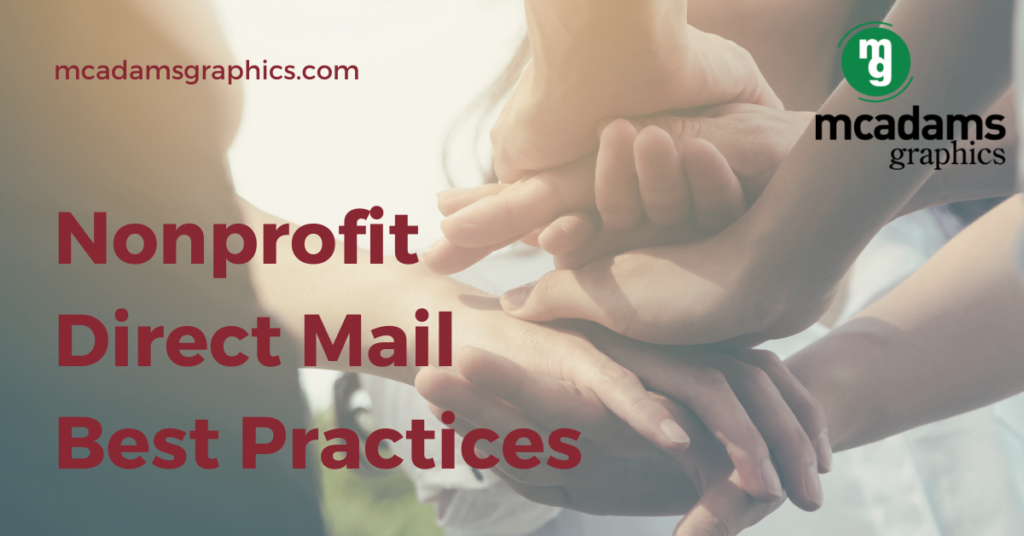
Nonprofit Direct Mail Best Practices to Target Donors and Volunteers
You know the catalogs, letters, and postcards you receive at home and work? Those are examples of direct mail.
Direct mail is a marketing tactic used to reach target audiences in a tangible way. Nonprofit organizations incorporate direct mail into their overall marketing strategy to build awareness, fundraise, recruit volunteers, retain donors, and advertise.
Though it might seem like an outdated form of communication, direct mail is well-received by consumers. Unlike email, which has an open rate of 20-30%, direct mail is opened up to 90% of the time. Additionally, 42% of direct mail recipients read or scan their direct mail.
So what makes direct mail marketing so effective for nonprofits? If you have accurate data, you can segment your audience so your message reaches those most likely to support your cause. The tangibility of direct mail helps recipients build a stronger personal connection with your organization, resulting in higher engagement. And just because direct mail is analog doesn’t mean you can’t track the results of your campaigns. By including unique URLs or QR codes, for example, you can track the effectiveness of your campaigns.
7 Tips for Successful Nonprofit Direct Mail Campaigns
Now that you see the value of direct mail for nonprofits, you want to add it to your nonprofit marketing strategy. Follow these top tips for making your direct mail marketing campaigns successful.
1. Set a Goal and Have a Plan
Just like your other marketing tactics, nonprofit direct mail campaigns require upfront planning and goal-setting to be effective. As you develop your campaign, here are the key things to consider before sending your first piece of direct mail.
-
Your Audience
As a nonprofit, you likely have several audiences. You have volunteers and donors. If you provide a service, you have customers. If you help a defined geographic area, you also have constituents.
-
Desired Action
What do you want your recipients to do when they read your direct mail? Your answer will vary depending on which audience you are targeting. Nevertheless, being clear on this point will make crafting your message and tracking campaign results easier.
-
Campaign Timeline
As with any other project you manage, you must set a timeline with key milestones for your direct mail campaign. Longterm projects benefit from a timeline to help everyone stay on track.
-
Campaign Budget
Nonprofits often operate with tight budgets, making it all the more important for leadership and marketing teams to define a campaign budget together. Knowing your maximum spend gives focus to your campaign. Which audience can you best serve? Which message could offer the highest return on your investment? Something else to keep in mind: In 2017, the average amount spent on direct mail was $167 per person. Direct mail may not be the cheapest marketing tactic, but it can yield a return on investment of up to 1,300%!
-
The Story
Your direct mail piece must catch and hold recipients’ attention to be effective. Make every word count by being strategic with your messaging. Use storytelling (see Tip 5 for more information) to create an emotional connection with the reader–this is more memorable than a list of numbers or facts.
-
Campaign Goals
Why are you sending this campaign? It might seem like a silly question, but it matters a great deal to your campaign’s success. The purpose of the campaign should align with your target audience, call to action, and messaging. We recommend setting SMART (specific, measurable, attainable, relevant, and time-bound) goals for all of your campaigns. Comparing the end results with these clearly defined goals will tell you whether your campaign was a hit or a flop. You can then take your findings and apply them to your next campaign–that way you’re always learning and improving.
2. Hook Your Audience and Compel Them to Act
Getting your nonprofit direct mail campaign to your target audience may seem like a big hurdle, but what you really need to focus your attention on is engaging recipients so they open, read, and act on your message.
The first step toward achieving that is to make the first few sentences of your message compelling. You have to grab your recipients’ attention and draw them in so they want to keep reading. Do this by starting with a strong hook–include a personal story or surprising facts and figures.
Remember the desired action you included in your campaign plan? Now it’s time to create a sense of urgency to encourage your readers to follow through. Making the action time-sensitive by including a deadline is an effective way to motivate recipients to act. Take it a step further by making your request specific.
Let’s say the goal of your direct mail campaign is to raise $20,000 to purchase a vehicle for a new mobile food pantry to serve your community. For your hook, you could share recent statistics on the number of individuals and families in your area facing food insecurity. To motivate your readers to give, say, “We need $20,000 by May 1.” Make your message even more compelling by demonstrating the impact of their donation. “Your gift will help us reach underserved members of our community struggling to feed their families.”
3. Make Your Audience Feel Special
“A person who feels appreciated will always do more than what is expected.” -Unknown
Taking small steps to make your audience feel valued will go a long way. Communicating your appreciation consistently can lead donors to give more of their time and money. Over time, your repeated appreciation can motivate your audience to get involved in other ways. Some may even become advocates for your cause, drawing in new volunteers or donors.
Here are two simple ways to make your audience feel special with direct mail marketing: personalization and exclusivity. Partner with a professional printing company that offers variable data printing; they can personalize your campaign using the data in your CRM. This is a special touch that will increase the odds of your recipients opening your direct mail piece and taking the desired action. Humans have an innate desire for connection. Nonprofit direct mail can help your organization satisfy that by creating a sense of community around your cause. When people feel connected in this way, they’re more likely to act.
4. What’s in it For Them?
Charitable giving doesn’t come with the same strings attached that purchasing consumer goods does. But donors and volunteers still have expectations for nonprofits: they want to know how their gifts of money or time will benefit your organization.
Your nonprofit marketing messaging should address this. Be sure to include this information in your direct mail campaign, and be specific. Remember our mobile food pantry example from Tip 2: “Your gift will help us reach underserved members of our community struggling to feed their families.” Your supporters want to know their contributions matter. Don’t miss opportunities to show them the impact they’re making.
5. Tell a Story
Boring pieces of nonprofit direct mail get thrown in the trash. This is why you must start off your message with a hook and why creating a sense of urgency is essential to the success of your campaign.
Don’t disregard what comes between the hook and the ask. The body of your message should tell a story. Would you rather read a list of statistics about food insecurity or about a local mom whose family has consistently received nutritious food thanks to the donors who funded the mobile food pantry?
The latter creates an emotional connection between the reader and the mom. The reader feels compassion toward her and wants to do their part to ensure she and her children can continue to get the nutritional support they need. It’s important to make your reader the hero of the story you’re telling and not your cause or organization.
6. Be Clear in Your Ask
Remember: part of campaign planning is to have a desired action for your readers. If your audience reads your direct mail but is confused, they won’t take action, and you won’t meet your campaign goals.
Define a single appeal for your campaign. Focusing on one call to action in your nonprofit direct mail prevents reader confusion. Make your ask short and specific and you’ll increase the likelihood that recipients take the desired action.
7. Choose Images That Enhance Your Story
You know the saying “A picture is worth a thousand words?” Use it to your advantage!
Compelling imagery can make your nonprofit direct mail campaign more effective and increase ROI. Swap stock photos for pictures showing your organization in action. Images that stir up your recipients’ emotions are more likely to motivate them to take action. And authenticity helps build trust between direct mail recipients and your organization.
McAdams Graphics Can Support Your Next Direct Mail Marketing and Print Marketing Campaigns
When it comes to nonprofit marketing strategy, direct mail is an effective tactic to include. Your organization can use it for everything from advertising to volunteer recruitment. Though it can have a higher upfront cost than other tactics, direct mail marketing can yield high returns for your cause. Make the most of this tactic by implementing these 7 tips.
For over 35 years, McAdams Graphics has supported nonprofits in their direct mail marketing, and we’d love to help your organization too. Contact us today, and our experienced team will help set your nonprofit marketing up for success.

